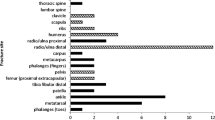Abstract
While axial dual energy X-ray absorptiometry (DXA) is the accepted ‘gold standard’ method both for diagnosing osteoporosis and predicting fractures, appropriate equipment is not universally available. Peripheral bone mass measurements may have the potential to identify patients at risk of fracture and to be used to target appropriate treatment. We assessed the effectiveness of peripheral DXA (PIXI, GELunar) in the assessment of risk and targeting treatment to prevent future fracture in 7,604 women aged 60–80 from five centres across Britain. At enrolment women completed a lifestyle and risk factor questionnaire and had a PIXI DXA scan of the heel. Women were categorised by PIXI DXA bone mineral density (BMD) into high, medium or low risk of future osteoporotic fracture. Treatment was recommended to those at highest risk. Follow-up was by simple questionnaire 18–24 months after baseline assessment. Seventy-four percent returned the follow-up questionnaire. The area under the receiver operator characteristic (ROC) curves for any fracture and osteoporotic fracture were comparable to those published using other sites and technologies. A 1-SD decrease in PIXI BMD was associated with an 86% increase in risk of osteoporotic fracture. Of the women identified as high risk, 74% had started treatment following their heel scan and 84.7% continued to take treatment at follow-up. No significant difference was noted in fracture rates in those who started treatment after assessment compared to those who did not. While peripheral DXA is highly effective for predicting older women who are at increased risk of future fracture, it has yet to be established as an effective method for targeting bisphosphonate or other therapy.

Similar content being viewed by others
References
Torgerson DJ, Iglesias CP, Reid DM (2001) The economics of fracture prevention. Effective Management of Osteoporos 2001:111–121
Schurch MA, Rizzoli R, Mermillod B, Vasey H, Michel JP, Bonjour JP (1996) A prospective study on socioeconomic aspects of fracture of the proximal femur. J Bone Miner Res 11:1935–1942
Cummings SR, Black DM, Nevitt MC, Browner W, Cauley J, Ensrud K et al (1993) Bone density at various sites for prediction of hip fractures. Study of Osteoporotic Fractures Research Group. Lancet 341:72–75
Kanis JA (2002) Diagnosis of osteoporosis and assessment of fracture risk. Lancet 359:1929–1936
Marshall D, Johnell O, Wedel H (1996) Meta-analysis of how well measures of bone mineral density predict occurrence of osteoporotic fractures. BMJ 312:1254–1259
Kanis JA, Delmas P, Burckhardt P, Cooper C, Torgerson D (1997) Guidelines for diagnosis and management of osteoporosis. European Foundation for Osteoporosis and Bone Disease. Osteoporos Int 7:390–406
Miller PD, Bonnick SL, Rosen CJ (1996) Consensus of an international panel on the clinical utility of bone mass measurements in the detection of low bone mass in the adult population. Calcif Tissue Int 58:207–214
Pearson D, Masud T, Sahota O, Earnshaw S, Hosking D (2003) A comparison of calcaneal dual-energy X-ray absorptiometry and calcaneal ultrasound for predicting the diagnosis of osteoporosis from hip and spine bone densitometry. J Clin Densitom 6:345–352
Fordham JN, Chinn DJ, Kumar N (2000) Identification of women with reduced bone density at the lumbar spine and femoral neck using BMD at the os calcis. Osteoporos Int 11:797–802
Miller PD, Siris ES, Barrett-Connor E, Faulkner KG, Wehren LE, Abbott TA et al (2002) Prediction of fracture risk in postmenopausal white women with peripheral bone densitometry: evidence from the National Osteoporosis Risk Assessment. J Bone Miner Res 17:2222–2230
Porthouse J, Birks YF, Torgerson DJ, Cockayne S, Puffer S, Watt I (2004) Risk factors for fracture in a UK population: a prospective cohort study. QJM 97:569–574
Kirk JK, Nichols M, Spangler JG (2002) Use of a peripheral dexa measurement for osteoporosis screening. Fam Med 34:201–205
Black DM, Thompson DE, Bauer DC, Ensrud K, Musliner T, Hochberg MC et al (2000) Fracture risk reduction with alendronate in women with osteoporosis: the Fracture Intervention Trial. FIT Research Group. J Clin Endocrinol Metab 85:4118–4124
Ismail AA, O’Neill TW, Cockerill W, Finn JD, Cannata JB, Hoszowski K et al (2000) Validity of self-report of fractures: results from a prospective study in men and women across Europe. EPOS Study Group. European Prospective Osteoporosis Study Group. Osteoporos Int 11:248–254
Acknowledgements
We are grateful to Procter & Gamble and Alliance for Better Bone Health for unrestricted grants, which enabled us to collect the original data, undertake the postal follow-up and the subsequent data analysis. DMR is grateful to the Arthritis Research Council for continued infrastructure reporting. We also acknowledge the contributions of the research staff at the centres that undertook the initial scans and assisted with the mechanics of the postal follow-up. They included Rena Sandison and Anne Baird at the Aberdeen centre, Linda Campbell at the Barnsley centre, Annette Paton, Gill Letcher and Bronwen Evans at the Lancaster centre, Nicola Wherley at the Liverpool centre and Christine Heron at the Romford centre.
Author information
Authors and Affiliations
Corresponding author
Rights and permissions
About this article
Cite this article
Barr, R.J., Adebajo, A., Fraser, W.D. et al. Can peripheral DXA measurements be used to predict fractures in elderly women living in the community?. Osteoporos Int 16, 1177–1183 (2005). https://doi.org/10.1007/s00198-005-1836-1
Received:
Accepted:
Published:
Issue Date:
DOI: https://doi.org/10.1007/s00198-005-1836-1




